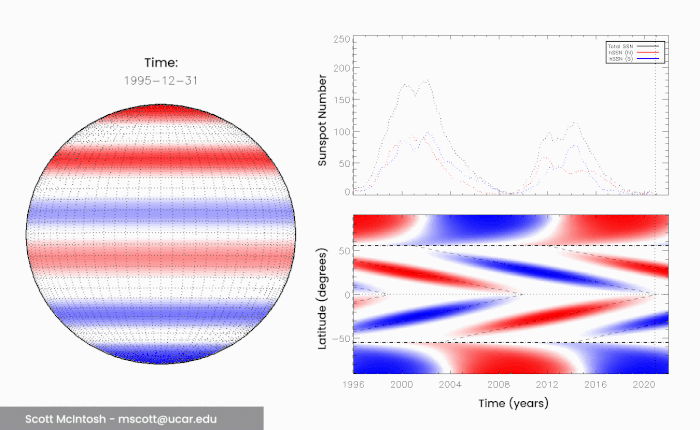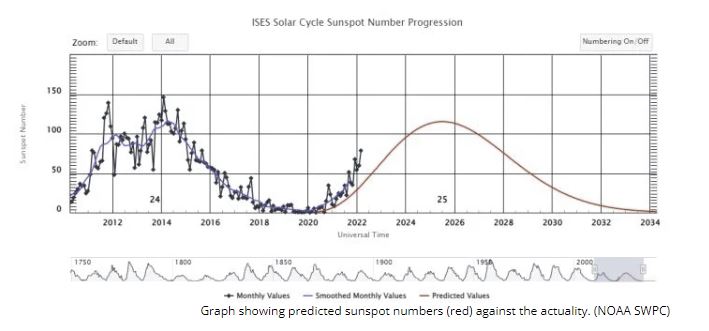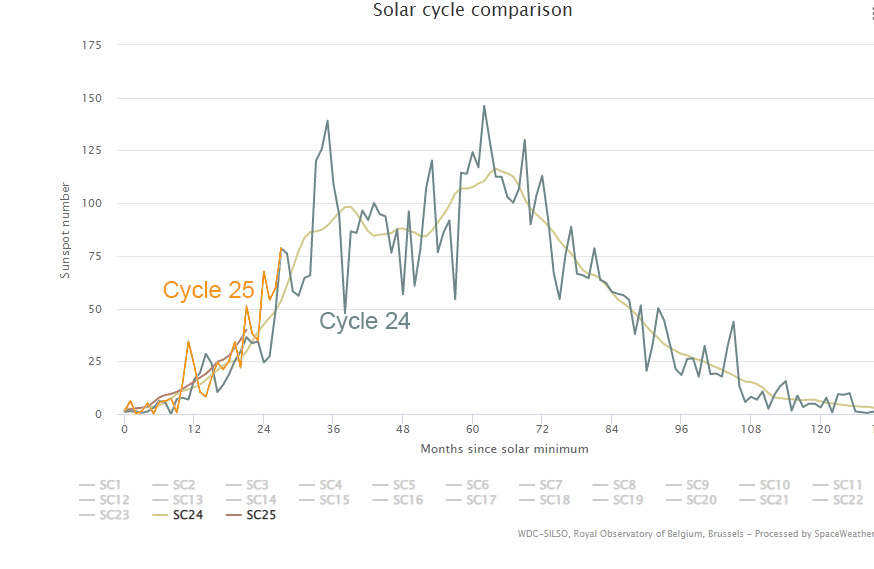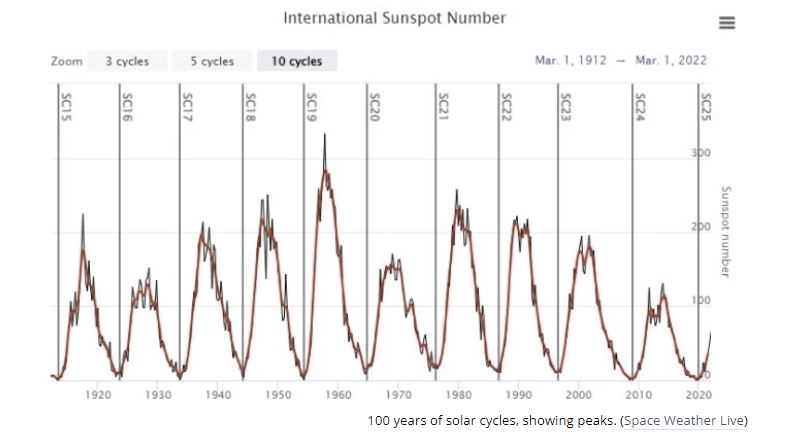There’s an electromagnetic ball of fire that is 1.3 million times the size of Earth and just 8 minutes away by photon, and we really don’t know what’s going on there.
Climate models assume the solar wind and magnetic field has no effect on our climate. But we find solar patterns everywhere from the prehistoric climate of Greenland, the North Atlantic jet stream, and even in human fertility and lifespan and jellyfish plagues.
Historians will mock us for trying to predict Earth’s climate when we are in the baby days of Space Weather knowledge. Solar Cycle 24 (the last one) was a shorter cycle, just under 10 years. Right now the big question is whether Solar Cycle 25 will be bigger and more active which seems to happen after a short cycle. But it’s too early to tell. This top graph overstates the effect.
Sunspot Activity on The Sun Is Seriously Exceeding Official Predictions
The Solar Cycle Prediction Panel predicted that the 25th cycle since record-keeping began would be similarly quiet, with a peak of 115 sunspots. By contrast, the number of sunspots for the last 18 months has been consistently higher than predictions. At time of writing, the Sun has 61 sunspots, and we’re still over three years from solar maximum.
Cycle 25 has been consistently higher than Cycle 24, but it is all within the margins of noise.
It certainly doesn’t look like it will be “the highest on record”. h/t Eben.
So there are battles over predictions but they are all guessing, including the author of this press release, and the top graph, Scott McIntosh, who admits as much:
A solar cycle following a longer cycle, they noticed, was likely to be on the weaker side. But a cycle following a shorter cycle was likely to be stronger. Solar Cycle 23 was long, which is consistent with the weakness of Solar Cycle 24. But Solar Cycle 24 was also short, coming in at just under 10 years.
This, McIntosh and his colleagues predicted in 2020, meant that Solar Cycle 25 was likely to be stronger – perhaps among the strongest on record. And the climbing sunspot numbers would suggest they may have been onto something.
“Scientists have struggled to predict both the length and the strength of sunspot cycles because we lack a fundamental understanding of the mechanism that drives the cycle,” McIntosh said at the time.
Though for the solar nerds, McIntosh explained his reasons back in 2020:
If he’s right and extreme UV marks the magnetic fields moving in waves, it’s just one more factor that’s missing in the models. Climate modelers think the Sun is just a ball of light, and fill all the gaps in their understanding with the hypothetical effect of “CO2”.
In 2014, he and his colleagues published a paper describing their observations of the Sun on a 22-year cycle.
This has long been considered the full solar cycle, when the poles return to their starting positions, but McIntosh noticed something interesting. Over the course of about 20 years or so, flickers of extreme ultraviolet light called coronal bright points seem to move from the poles towards the equator, meeting in the middle.
The movement of these bright points across the mid-latitudes seems to coincide with sunspot activity.

It’s really more of a 22 year cycle on the sun before the North pole gets back to where it started.
These bright points, McIntosh believes, are linked with bands of magnetic fields that wrap around the Sun, propagating from the poles to the equator every 11 years or so.
Because they have opposite polarity, when they meet in the middle, they cancel each other out – what the researchers call a “terminator”. These terminator events mark the end of a solar magnetic cycle, and the start of the next.
But they don’t always take exactly the same amount of time. Sometimes these bands slow down as they reach mid-latitudes, which means that the length of time between terminator events varies. And the team noticed that there’s a correlation between the length of time between terminators and the intensity of the following solar maximum.
“When we look back over the 270-year long observational record of terminator events, we see that the longer the time between terminators, the weaker the next cycle,” said astronomer Bob Leamon of the University of Maryland Baltimore County.
“And, conversely, the shorter the time between terminators, the stronger the next solar cycle is.”
These solar cycles we don’t understand leave a mark on Earth’s atmospheric pressure, the Central European floods, wind and rain in Chile, Australia and Asia and even in the groundwater recharge rate in China. Maybe that matters?


